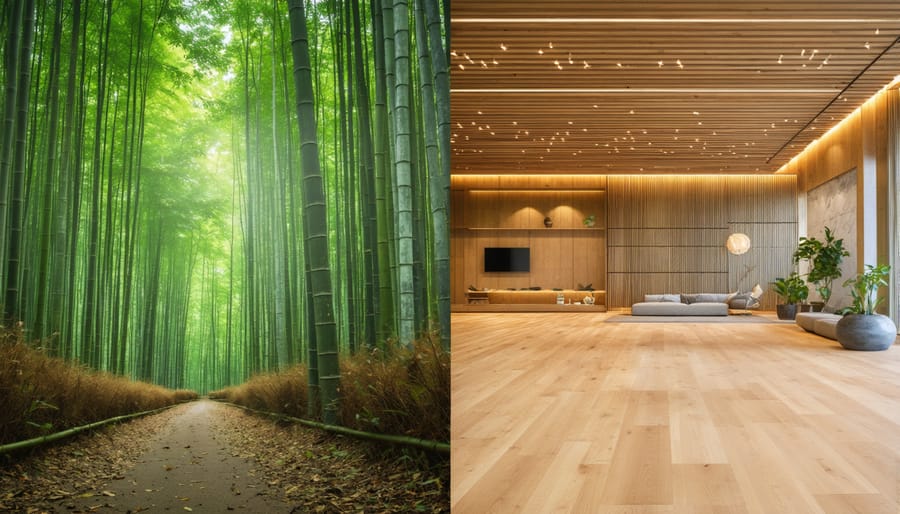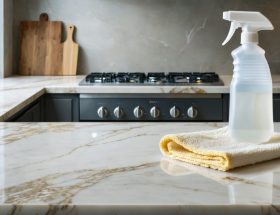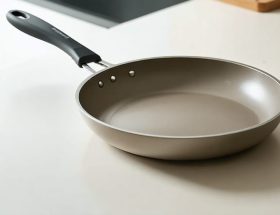Bamboo flooring stands at the crossroads of sustainability and modern design, offering homeowners a compelling alternative to traditional hardwood. As one of the fastest-growing plants on Earth, bamboo can transform from seedling to harvest-ready material in just 5-7 years – a fraction of the 20-plus years required for hardwood trees. This remarkable renewable resource has surged in popularity among eco-conscious consumers and design professionals, yet its adoption demands careful consideration of both advantages and limitations.
Beyond its environmental credentials, bamboo flooring presents a unique combination of aesthetic appeal, durability, and price point that merits thorough evaluation. While its natural beauty and variety of finishes can enhance any interior space, factors such as moisture sensitivity and varying manufacturing quality standards create important considerations for potential buyers. Whether you’re renovating a residential space or specifying materials for a commercial project, understanding the complete picture of bamboo flooring’s strengths and weaknesses is essential for making an informed decision that aligns with your specific needs and circumstances.
This comprehensive analysis explores the critical factors that influence bamboo flooring’s performance, maintenance requirements, and long-term value, helping you navigate the decision-making process with confidence.
The Environmental Impact of Bamboo Flooring
Sustainability Benefits
Bamboo stands out as one of the most sustainable eco-friendly building materials available today. Unlike hardwood trees that can take 20-120 years to mature, bamboo reaches harvesting maturity in just 3-5 years. This rapid growth rate makes bamboo an incredibly renewable resource, capable of replenishing itself quickly without depleting forest resources.
The plant’s environmental benefits extend beyond its growth cycle. Bamboo naturally requires minimal pesticides and fertilizers to thrive, reducing chemical usage in cultivation. Its extensive root system helps prevent soil erosion and can actually improve soil quality over time. Additionally, bamboo forests are efficient carbon sinks, absorbing up to 35% more carbon dioxide than equivalent stands of trees.
During processing, bamboo flooring production typically requires less energy than traditional hardwood manufacturing. Many bamboo flooring products are also made using low-VOC adhesives and finishes, contributing to better indoor air quality. The material’s long lifespan, when properly maintained, further enhances its sustainability credentials by reducing the need for frequent replacements.
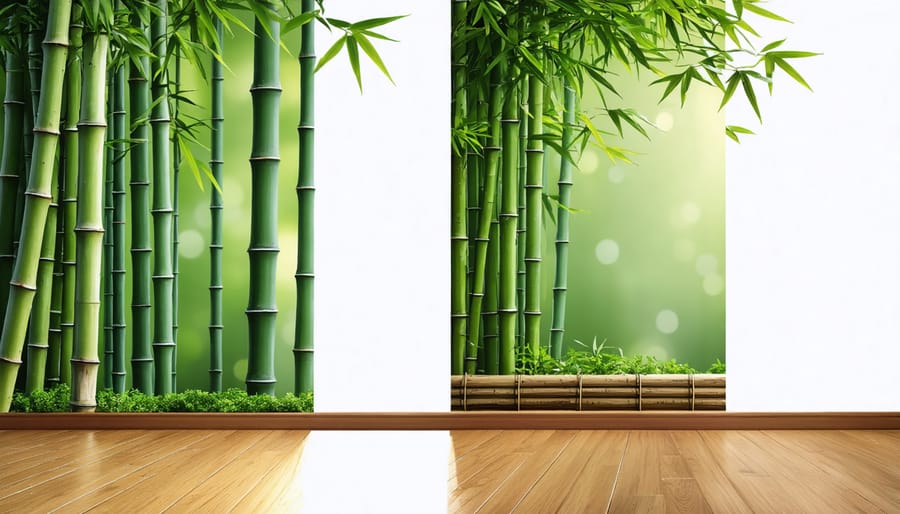
Environmental Concerns
While bamboo flooring is often marketed as an eco-friendly choice, its environmental impact requires careful consideration. The rapid growth rate of bamboo (3-5 years to maturity) makes it a naturally renewable resource, especially compared to hardwood trees that take decades to mature. However, most bamboo flooring is manufactured in Asia, primarily China, resulting in significant carbon emissions during transportation to Western markets.
The processing of bamboo into flooring materials also raises environmental concerns. Converting bamboo stalks into flooring requires extensive manufacturing, including stripping, boiling, and pressing the material. These processes often involve chemical treatments, particularly adhesives containing formaldehyde, which can affect indoor air quality. Some manufacturers now offer low-VOC options, but these typically come at a premium.
Deforestation is another consideration, as some bamboo plantations replace natural forests. While sustainable bamboo farming practices exist, the increasing demand has led some producers to clear existing ecosystems for bamboo cultivation. Consumers interested in minimizing environmental impact should seek products certified by recognized environmental organizations and manufacturers who demonstrate transparent, sustainable practices.
Durability and Performance
Strength and Hardness
When comparing flooring material options, bamboo’s strength often surprises homeowners. Quality strand-woven bamboo flooring can achieve Janka hardness ratings of up to 3,000 pounds-force, significantly surpassing traditional hardwoods like oak (1,290) and maple (1,450). This exceptional hardness makes bamboo highly resistant to dents, scratches, and daily wear.
However, not all bamboo flooring is created equal. The manufacturing process and harvesting time significantly impact its durability. Strand-woven bamboo offers the highest strength, while traditional horizontal and vertical bamboo constructions typically rate lower on the Janka scale, around 1,380-1,720 pounds-force.
The hardness advantage comes with some considerations. While bamboo resists denting well, it can be more prone to scratching than some hardwoods due to its cellular structure. The surface finish plays a crucial role in scratch resistance, with aluminum oxide finishes providing the best protection.
Environmental factors also affect bamboo’s strength. Like hardwood, bamboo can expand, contract, or warp in response to humidity changes. Proper acclimation before installation and maintaining consistent indoor humidity levels helps preserve its structural integrity and prevent potential issues.
Understanding these strength characteristics is essential for determining whether bamboo flooring suits your specific needs and usage patterns.
Moisture Resistance
Bamboo flooring’s relationship with moisture is a critical consideration that can significantly impact its long-term performance. While bamboo is naturally more moisture-resistant than traditional hardwoods, it’s not completely immune to water damage. In high-humidity environments, bamboo planks can absorb moisture, leading to swelling, warping, or cupping. Conversely, in very dry conditions, the material may contract and develop gaps between planks.
To maintain stability, bamboo flooring requires a consistent indoor humidity level between 35% and 55%. Installations in bathrooms, basements, or regions with significant humidity fluctuations require careful consideration and proper moisture barriers. Strand-woven bamboo tends to be more moisture-resistant than traditional horizontal or vertical bamboo flooring due to its manufacturing process and density.
Spills should be cleaned promptly to prevent moisture from seeping between planks or into the material. Standing water can cause staining, warping, and even mold growth if left unaddressed. Professional installation with appropriate underlayment and moisture barriers is crucial for protecting the flooring from subfloor moisture issues.
For homes in coastal areas or regions with high humidity, it’s essential to acclimate bamboo flooring materials to the installation environment for at least 72 hours before installation. This process helps minimize potential moisture-related problems and ensures better long-term performance.
Installation and Maintenance
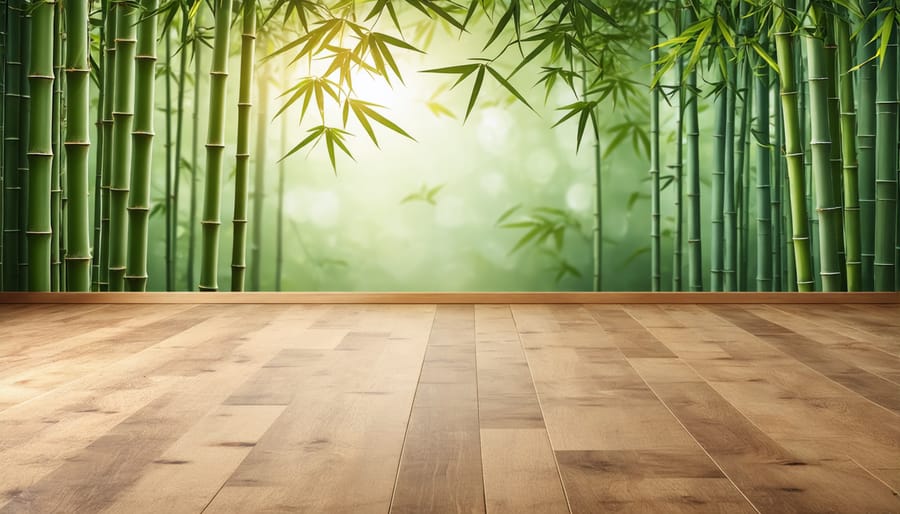
Installation Requirements
Bamboo flooring installation requires careful consideration of several key factors to ensure optimal performance and longevity. The subfloor must be clean, dry, and level, with moisture content not exceeding 12%. Acclimation is crucial – bamboo planks should be stored in the installation space for at least 48-72 hours to adjust to the room’s temperature and humidity levels.
While some homeowners opt for DIY installation, following professional installation techniques is recommended due to bamboo’s unique characteristics. The material can be installed using three primary methods: nail-down, glue-down, or floating installation. Nail-down installation works best over wood subfloors, while glue-down is ideal for concrete substrates. Floating installation, where planks connect to each other but not to the subfloor, offers the most versatility.
Special attention must be paid to expansion gaps around the perimeter of the room, as bamboo responds to environmental changes. These gaps, typically 1/2 inch wide, allow the flooring to expand and contract naturally without buckling. Installation should occur in rooms with relative humidity between 35-55% and temperature between 60-80°F to prevent future problems.
The installation surface should be thoroughly tested for moisture using reliable moisture meters, and appropriate moisture barriers or underlayment should be used based on the subfloor type and installation method chosen.
Daily Care and Long-term Maintenance
Regular cleaning of bamboo flooring requires gentle methods to maintain its beauty and durability. Daily sweeping or vacuuming with a soft-bristled attachment removes dirt and debris that could scratch the surface. For weekly cleaning, use a slightly damp mop with a pH-neutral cleaner specifically formulated for hardwood or bamboo floors. Avoid excessive water, as standing moisture can damage bamboo and cause warping.
To protect your bamboo flooring long-term, place felt pads under furniture legs and use protective mats in high-traffic areas or under rolling chairs. Maintain indoor humidity levels between 35-55% to prevent the bamboo from expanding or contracting excessively. Clean up spills immediately to prevent staining and water damage.
Consider refinishing your bamboo floors every 5-7 years, depending on wear and tear. Unlike traditional hardwood, bamboo flooring typically can only be refinished 1-2 times due to its thickness and construction. Watch for signs of wear such as scratches, dullness, or discoloration to determine when refinishing is needed.
Prevention is key to maintaining bamboo flooring. Use entrance mats to catch dirt and moisture, trim pet nails regularly, and avoid wearing high heels or shoes with hard soles on the floor. When moving furniture, always lift rather than drag to prevent scratches and gouges.
Cost Considerations
Initial Investment
When considering budget-friendly home improvements, bamboo flooring presents an attractive middle-ground option in terms of initial investment. Typically, bamboo flooring costs between $5 to $8 per square foot for materials, positioning it above laminate ($1-3) but below hardwood ($8-15). Installation costs usually range from $4 to $6 per square foot, making the total project cost approximately $9-14 per square foot installed.
The price varies significantly based on the bamboo’s quality, construction method (strand-woven being more expensive than horizontal or vertical), and finish. While premium bamboo options can rival high-end hardwood prices, many mid-range bamboo products offer excellent value for their durability and aesthetic appeal.
For a standard 200-square-foot room, homeowners can expect to invest between $1,800 and $2,800 for materials and professional installation. This investment level makes bamboo flooring a competitive option for those seeking the look of hardwood without its premium price tag, while still maintaining superior quality compared to synthetic alternatives.
Long-term Value
When properly maintained, bamboo flooring can last 20-25 years, offering significant long-term value for homeowners. While the initial cost may be higher than some traditional hardwood options, bamboo’s durability and resistance to wear make it a cost-effective choice over time. Premium bamboo flooring typically costs between $5-8 per square foot, with professional installation adding another $3-5 per square foot.
Maintenance costs remain relatively low, requiring only regular sweeping and occasional damp mopping with a bamboo-specific cleaner. Unlike carpet that needs frequent replacement or vinyl that can wear quickly in high-traffic areas, bamboo maintains its appearance with minimal upkeep. However, refinishing costs should be considered, as bamboo may need refreshing every 5-7 years depending on wear patterns.
From an investment perspective, bamboo flooring can positively impact property value, particularly in markets where eco-friendly features are highly valued. While it may not offer the same return on investment as traditional hardwood, its unique aesthetic and environmental benefits make it an attractive selling point for environmentally conscious buyers.
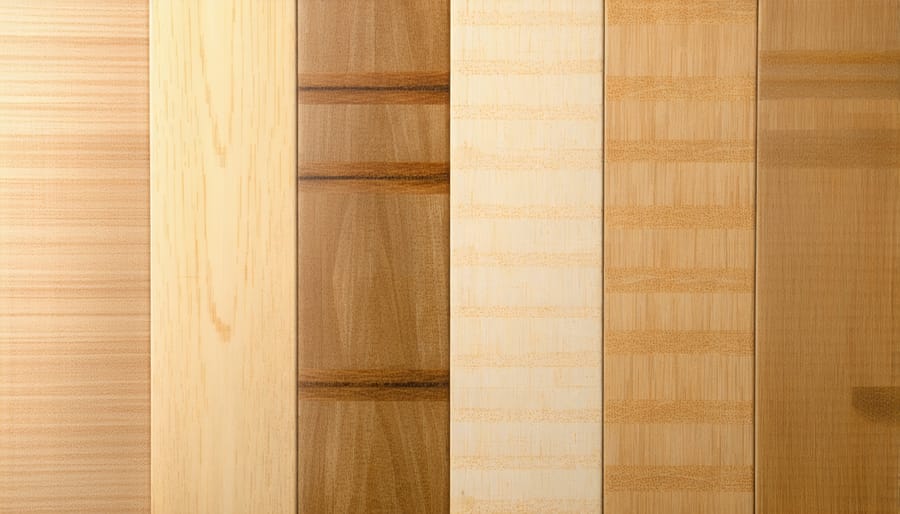
Style and Design Options
Bamboo flooring offers an impressive range of style options to suit various interior design preferences. The material comes in two main visual varieties: horizontal and vertical grain patterns. Horizontal grain showcases bamboo’s distinctive nodes for a more natural, organic appearance, while vertical grain presents a more uniform, contemporary look.
Color options are extensive, ranging from light natural blonde to deep espresso tones. Through a process called carbonization, bamboo can be pressure-heated to create darker, amber-rich hues without using stains. This technique allows for warm, rich colors while maintaining the material’s natural character. Strand-woven bamboo offers even more variety, with textures that can convincingly mimic traditional hardwoods like oak or maple.
Available finishes include glossy, semi-gloss, and matte options. Many manufacturers offer both prefinished and unfinished planks, giving homeowners the flexibility to customize their floor’s final appearance. Plank widths typically range from 3.5 to 7.5 inches, with various thickness options available to suit different installation needs.
Modern manufacturing techniques have expanded design possibilities beyond traditional solid planks. Engineered bamboo flooring features a bamboo veneer over a stable core material, offering enhanced versatility for different installation scenarios. Some manufacturers also produce bamboo flooring with hand-scraped or distressed surfaces for a more rustic, lived-in appearance.
Pattern options include traditional straight layouts, diagonal installations, and even herringbone designs for more sophisticated applications. Many collections also feature coordinating trim pieces like quarter round, reducers, and stair nosing, allowing for seamless transitions and finished looks throughout the space.
Bamboo flooring offers a unique combination of sustainability, aesthetics, and practicality, but its suitability depends largely on your specific needs and circumstances. For high-traffic residential areas and environments with stable humidity, bamboo can be an excellent choice, particularly strand-woven varieties that offer superior durability. The eco-friendly nature and competitive pricing make it especially attractive for environmentally conscious homeowners working within a moderate budget.
However, those living in areas with significant humidity fluctuations or those seeking flooring for moisture-prone spaces should carefully consider alternatives. While bamboo’s maintenance requirements aren’t excessive, its sensitivity to moisture and potential for scratching may not suit every lifestyle.
For optimal results, consider strand-woven bamboo for high-traffic areas, carbonized bamboo for rich color preferences (understanding it’s slightly softer), and traditional bamboo for moderate-use spaces. Always purchase from reputable manufacturers, ensure proper acclimation before installation, and maintain consistent indoor humidity levels. With proper care and appropriate application, bamboo flooring can provide a beautiful, sustainable, and durable flooring solution that enhances your space while supporting environmental consciousness.

